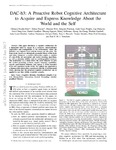DAC-h3: A Proactive Robot Cognitive Architecture to Acquire and Express Knowledge About the World and the Self
| dc.contributor.author | Moulin-Frier, C | |
| dc.contributor.author | Fischer, T | |
| dc.contributor.author | Petit, M | |
| dc.contributor.author | Pointeau, G | |
| dc.contributor.author | Puigbo, J-Y | |
| dc.contributor.author | Pattacini, U | |
| dc.contributor.author | Low, SC | |
| dc.contributor.author | Camilleri, D | |
| dc.contributor.author | Nguyen, P | |
| dc.contributor.author | Hoffmann, M | |
| dc.contributor.author | Chang, HJ | |
| dc.contributor.author | Zambelli, M | |
| dc.contributor.author | Mealier, A-L | |
| dc.contributor.author | Damianou, A | |
| dc.contributor.author | Metta, Giorgio | |
| dc.contributor.author | Prescott, TJ | |
| dc.contributor.author | Demiris, Y | |
| dc.contributor.author | Dominey, PF | |
| dc.contributor.author | Verschure, PFMJ | |
| dc.date.accessioned | 2017-06-23T15:22:46Z | |
| dc.date.available | 2017-06-23T15:22:46Z | |
| dc.date.issued | 2018-12 | |
| dc.identifier.issn | 2379-8920 | |
| dc.identifier.issn | 2379-8939 | |
| dc.identifier.uri | http://hdl.handle.net/10026.1/9527 | |
| dc.description | Preprint version; final version available at http://ieeexplore.ieee.org/ IEEE Transactions on Cognitive and Developmental Systems (Accepted) DOI: 10.1109/TCDS.2017.2754143 | |
| dc.description.abstract |
This paper introduces a cognitive architecture for a humanoid robot to engage in a proactive, mixed-initiative exploration and manipulation of its environment, where the initiative can originate from both human and robot. The framework, based on a biologically grounded theory of the brain and mind, integrates a reactive interaction engine, a number of state-of-the-art perceptual and motor learning algorithms, as well as planning abilities and an autobiographical memory. The architecture as a whole drives the robot behavior to solve the symbol grounding problem, acquire language capabilities, execute goal-oriented behavior, and express a verbal narrative of its own experience in the world. We validate our approach in human-robot interaction experiments with the iCub humanoid robot, showing that the proposed cognitive architecture can be applied in real time within a realistic scenario and that it can be used with naive users. | |
| dc.format.extent | 1005-1022 | |
| dc.language.iso | en | |
| dc.publisher | Institute of Electrical and Electronics Engineers (IEEE) | |
| dc.subject | Autobiographical memory (ABM) | |
| dc.subject | cognitive robotics | |
| dc.subject | distributed adaptive control (DAC) | |
| dc.subject | human-robot interaction (HRI) | |
| dc.subject | symbol grounding | |
| dc.title | DAC-h3: A Proactive Robot Cognitive Architecture to Acquire and Express Knowledge About the World and the Self | |
| dc.type | journal-article | |
| dc.type | Journal Article | |
| plymouth.author-url | https://www.webofscience.com/api/gateway?GWVersion=2&SrcApp=PARTNER_APP&SrcAuth=LinksAMR&KeyUT=WOS:000452636400016&DestLinkType=FullRecord&DestApp=ALL_WOS&UsrCustomerID=11bb513d99f797142bcfeffcc58ea008 | |
| plymouth.issue | 4 | |
| plymouth.volume | 10 | |
| plymouth.publisher-url | http://dx.doi.org/10.1109/TCDS.2017.2754143 | |
| plymouth.publication-status | Published | |
| plymouth.journal | IEEE Transactions on Cognitive and Developmental Systems | |
| dc.identifier.doi | 10.1109/tcds.2017.2754143 | |
| plymouth.organisational-group | /Plymouth | |
| plymouth.organisational-group | /Plymouth/Faculty of Science and Engineering | |
| plymouth.organisational-group | /Plymouth/REF 2021 Researchers by UoA | |
| plymouth.organisational-group | /Plymouth/REF 2021 Researchers by UoA/UoA11 Computer Science and Informatics | |
| dcterms.dateAccepted | 2017-08-09 | |
| dc.rights.embargodate | 2023-6-21 | |
| dc.identifier.eissn | 2379-8939 | |
| dc.rights.embargoperiod | Not known | |
| rioxxterms.versionofrecord | 10.1109/tcds.2017.2754143 | |
| rioxxterms.licenseref.uri | http://www.rioxx.net/licenses/all-rights-reserved | |
| rioxxterms.type | Journal Article/Review |


